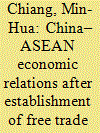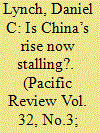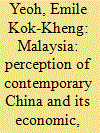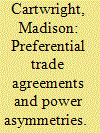|
|
|
Sort Order |
|
|
|
Items / Page
|
|
|
|
|
|
|
| Srl | Item |
| 1 |
ID:
165865


|
|
|
|
|
| Summary/Abstract |
This paper aims to contribute to an understanding about the major changes in China–ASEAN economic relations after establishment of the China–ASEAN Free Trade Area (CAFTA) in 2010. First, China's merchandize trade balance with ASEAN has shifted from deficit to surplus since 2012. This reflects China's improving comparative advantage in manufacturing production vis-à-vis ASEAN as a whole. Second, with China's wage hike, ASEAN investors can no longer take advantage of China's cheap labor force. Concurrently, China's investment in ASEAN has been increasing and become more diversified, ranging from energy to manufacturing and services. Singapore has remained the most important investment destination for Chinese investors and the largest foreign investor in China among ASEAN countries. Third, China has comparative advantages in providing construction, telecommunications, computer and information services and other business services to ASEAN. On the other hand, ASEAN, led by Singapore, has opportunities in the financial services and tourism markets in China. Finally, the development of economic regionalism, notably the Regional Comprehensive Economic Partnership and Trans-Pacific Partnership, will remain critical for the CAFTA's relevance in regional economic integration, as well as China–ASEAN relations in the future.
|
|
|
|
|
|
|
|
|
|
|
|
|
|
|
|
| 2 |
ID:
165869


|
|
|
|
|
| Summary/Abstract |
Whether it is the persecution of the Rohingya, the disappearance of human rights activists, the general limiting of freedom of speech across the region, or the resumption of the arbitrary use of the death penalty, Southeast Asia can be said to be facing a human rights crisis. This human rights crisis is though occurring at a time when the region’s institution, the Association of Southeast Asian Nations (ASEAN), has never been so interested in human rights. After a lengthy period of time in which ASEAN either ignored, or paid lip service to human rights, the Association has created a human rights body – the ASEAN Intergovernmental Commission on Human Rights (AICHR) – and adopted an ASEAN Human Rights Declaration (AHRD). In this article, I utilize the Spiral Model to explain how, when ASEAN member states are regressing in their commitment to human rights, an intergovernmental body continues to promote their commitment and lay the groundwork for their compliance.
|
|
|
|
|
|
|
|
|
|
|
|
|
|
|
|
| 3 |
ID:
165872


|
|
|
|
|
| Summary/Abstract |
The variations on power transition theory so widely used to frame analysis of U.S.–China relation tend to assume the inevitability or at least strong probability of China surpassing the United States in economic power if not necessarily military power. In the terminology of social psychology’s attribution theory, China is imputed with the identity of a state that is inevitably rising. The Chinese Communist Party encourages this attribution among Chinese people and foreigners. But China’s economic rise – the foundation of its comprehensive rise – appears to have entered an inflection point in the mid-2010s and may now be stalling. In critical respects, China increasingly resembles the last two countries that ‘attempted’ a globe-level rise: the unsuccessful cases of postwar Japan and the Soviet Union. China’s labor force is shrinking; the country relies excessively on unsustainable debt increases to fuel economic growth; and pollution is seriously harming public health. But even if China’s rise conclusively stalls, it may take quite some time before the Chinese public and outside observers recognize the new reality because of intrinsic biases in the cognitive logic of attributing identities to actors.
|
|
|
|
|
|
|
|
|
|
|
|
|
|
|
|
| 4 |
ID:
165870


|
|
|
|
|
| Summary/Abstract |
This article looks at the Malaysian perception of the contemporary rise of China by focusing more on the country’s societal response rather than from a broad overall perspective of international strategic relations and diplomacy. The Malaysian society is seen as a complex multi-entity construct, constituted by often sharply differentiated fragments and sub-fragments which could exhibit vastly different responses to the implications of the rise of China. Within such a construct, perception of the rise of China and the appropriate Malaysian response are intricately entwined with domestic power politics, generational transition and governmental control over public discourse. Hence, the Malaysian perception of the contemporary rise of China is as complex as the Malaysian society itself, and what is revealed in official government policies and public discourses in the dominant mass media would fail to reflect the real depth of the issue if the intrinsic complexity of the Malaysian society is not taken into due consideration.
|
|
|
|
|
|
|
|
|
|
|
|
|
|
|
|
| 5 |
ID:
165867


|
|
|
|
|
| Summary/Abstract |
Since the 1980s states have sought to harmonise economic standards to aid the flow of goods, services and finance across borders. The founding agreements of the World Trade Organisation (WTO), for example, harmonised standards on services, intellectual property and investment. However, mutlilateral trade negotiations in the WTO have since stalled. In response, the United States (US) has engaged in forum shopping, using preferential trade agreements at the bilateral, regional and multinational level to harmonise international standards. This article argues that through forum shopping the US has been able to export standards that support the commercial interests of US-based industries more than they encourage economic exchange across borders. Furthermore, because power asymmetries are starker in preferential trade negotiations smaller and middle power states should not enter trade agreements, which include regulatory harmonisation. This is illustrated with the case of the US-Australia free trade agreement, looking specifically at a copyright standard known as technological protection measures (TPMs). It was clear before, during and after the agreement was signed that Australia’s existing standard on TPMs was more popular than the US-style standard. Nevertheless, a US-style standard is in effect domestically because of the trade agreement.
|
|
|
|
|
|
|
|
|
|
|
|
|
|
|
|
| 6 |
ID:
165871


|
|
|
|
|
| Summary/Abstract |
In popular narratives, intellectual and media analysts believe the Diaoyu/Senkaku Islands dispute between China and Japan is a contestation for potential hydrocarbon reserves and other maritime rights which are per se divisible, but nationalism – particularly on China side – and relative power change between the two competing claimants make these territories increasingly indivisible and the dispute war-prone. Based on a review over People's Daily’s coverage of the disputes and other secondary information, this article reveals a different scenario by highlighting the political meanings of disputed territories for national cohesion and regime self-preservation. It finds, Beijing’s strategic moves in the disputes are influenced by its efforts at different occasions to de-legitimate Republic of China at Taiwan and defend its core interests – namely Taiwan and the "One-China" principle, to appease the patriotism in Hong Kong and facilitate the latter’s stable reversion to China in 1990s, and what is more, to rally popular support at home. In addition, Beijing’s Diaoyu/Senkaku strategy did not follow a carefully calculated path, but was mostly reactive to the contingencies and ultimately took shape through the incremental accumulation of previous policies and behaviours.
|
|
|
|
|
|
|
|
|
|
|
|
|
|
|
|
| 7 |
ID:
165866


|
|
|
|
|
| Summary/Abstract |
By comparing three Chinese pillar industries, automobile, petroleum, and machinery, this paper analyzes how the development of uneven institutional configurations bred sectoral variation in transitional China. In 1994, at the dawn of the Chinese socialist market economy, the State Council issued guidelines for national industrial policy and proposed the enactment of similar growth-promoting policies for all pillar industries. The level of policy enactment and the resulting outcomes, however, vary significantly across the industries. Previous literature on China's rapid industrialization has sought to build a single model encompassing China as a whole, and has emphasized either the state's institutional capacity or China's unique governance mechanisms. This study investigates China's industrialization by taking account of the uneven development of institutional capacity amid macro institutional reforms. Every idea and institution evolved at a different pace in these reforms, and the incremental nature of the reforms further deepened the gaps between sectors. This paper argues that, due to this uneven development, the Chinese state was not strong enough to be considered a developmental state until at least the early 2000s.
|
|
|
|
|
|
|
|
|
|
|
|
|
|
|
|
| 8 |
ID:
165868


|
|
|
|
|
| Summary/Abstract |
Despite the fact that the Korean nuclear crisis is one of the most protracted security issues in the world, the research analysing the crisis from the perspective of securitisation theory is curiously absent. This article attempts to pin down some distinguishing features of South Korea’s securitisation of the nuclear threat posed by North Korea, thereby investigating why one rarely sees the implications of securitisation theory in the way that the Copenhagen School theorists would suggest. Borrowing the key components of securitisation theory—existential threats, referent objects and extraordinary measures—this article suggests three elusive characteristics of the South Korean actors’ speech acts as sources highlighting the dilemma. To make the article’s arguments clearer, I hold Floyd’s classification of securitisation theory, which separated the securitisation process into two different stages: securitising move and security practice. While acknowledging the importance of the differences between illocution and perlocution in a securitisation process, this article takes this logic one step further by suggesting the limits of the perlocutionary effect in making the securitisation process complete.
|
|
|
|
|
|
|
|
|
|
|
|
|
|
|
|
|
|
|
|
|